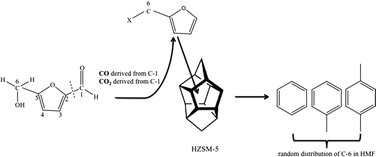Catalytic conversion of carbohydrate-derived oxygenates over HZSM-5 in a tandem micro-reactor system†
Abstract
In this study, carbohydrate-derived pyrolysis oxygenates were used as model compounds to investigate the effect of functional group and molecular size on the product formation from their catalytic conversion over HZSM-5. Functional groups in oxygenates were found to strongly affect the oxygen removal pathway, leading to variations in hydrocarbon formation. This study also found that oxygenates of smaller molecular size tended to form more hydrocarbons and less coke. Coking on the external surface of catalysts was greatest for the largest oxygenates. Isotopic labeling experiments demonstrated that the aldehyde group of HMF was cleaved before the furanic ring diffused into the HZSM-5 catalyst. Product distribution from catalytic pyrolysis of glucose was the same as the weighted sum of products obtained by the catalytic pyrolysis of individual oxygenates known to arise from non-catalytic pyrolysis of glucose. This suggests that oxygenates released during pyrolysis of carbohydrate have no significant interaction during their catalytic conversion over HZSM-5.


 Please wait while we load your content...
Please wait while we load your content...